Study of Microchannels Fabricated Using Desktop Fused Deposition Modeling Systems
Abstract
1. Introduction
2. Materials and Methods
2.1. Fabrication of Microchannels
2.2. Characterisation
3. Results and Discussion
4. Conclusions
Author Contributions
Funding
Acknowledgments
Conflicts of Interest
Abbreviations
| 3DP | Three dimensional printing |
| FDM | Fused deposition modeling |
| SLS | Selective laser sintering |
| SL | Stereolithography |
| PDMS | Polydimethylsiloxane |
| PLA | polylactic acid |
| TEB | total error band |
| FSS | full-scale span |
| UP02 | Tiertime UP 02 |
| Prusa | Original Prusa i3 MK3S |
References
- Kitson, P.J.; Rosnes, M.H.; Sans, V.; Dragone, V.; Cronin, L. Configurable 3D-Printed millifluidic and microfluidic ‘lab on a chip’reactionware devices. Lab Chip 2012, 12, 3267–3271. [Google Scholar] [CrossRef] [PubMed]
- Symes, M.D.; Kitson, P.J.; Yan, J.; Richmond, C.J.; Cooper, G.J.; Bowman, R.W.; Vilbrandt, T.; Cronin, L. Integrated 3D-printed reactionware for chemical synthesis and analysis. Nat. Chem. 2012, 4, 349–354. [Google Scholar] [CrossRef] [PubMed]
- Gelber, M.K.; Bhargava, R. Monolithic multilayer microfluidics via sacrificial molding of 3D-printed isomalt. Lab Chip 2015, 15, 1736–1741. [Google Scholar] [CrossRef]
- Hung, P.J.; Lee, P.J.; Sabounchi, P.; Lin, R.; Lee, L.P. Continuous perfusion microfluidic cell culture array for high-throughput cell-based assays. Biotechnol. Bioeng. 2005, 89, 1–8. [Google Scholar] [CrossRef] [PubMed]
- Waheed, S.; Cabot, J.M.; Macdonald, N.P.; Lewis, T.; Guijt, R.M.; Paull, B.; Breadmore, M.C. 3D printed microfluidic devices: Enablers and barriers. Lab Chip 2016, 16, 1993–2013. [Google Scholar] [CrossRef]
- Fan, Y.-Q.; Wang, H.-L.; Gao, K.-X.; Liu, J.-J.; Chai, D.-P.; Zhang, Y.J. Applications of Modular Microfluidics Technology. Chin. J. Anal. Chem. 2018, 46, 1863–1871. [Google Scholar] [CrossRef]
- Torino, S.; Corrado, B.; Iodice, M.; Coppola, G. Pdms-based microfluidic devices for cell culture. Inventions 2018, 3, 65. [Google Scholar] [CrossRef]
- Strong, E.B.; Knutsen, C.; Wells, J.T.; Jangid, A.R.; Mitchell, M.L.; Martinez, N.W.; Martinez, A.W. Wax-printed fluidic time delays for automating multi-step assays in paper-based microfluidic devices (MicroPADs). Inventions 2019, 4, 20. [Google Scholar] [CrossRef]
- Fu, L.M.; Tseng, C.C.; Ju, W.J.; Yang, R.J. Rapid paper-based system for human serum creatinine detection. Inventions 2018, 3, 34. [Google Scholar] [CrossRef]
- Ziaie, B.; Baldi, A.; Lei, M.; Gu, Y.; Siegel, R.A. Hard and soft micromachining for BioMEMS: Review of techniques and examples of applications in microfluidics and drug delivery. Adv. Drug Deliv. Rev. 2004, 56, 145–172. [Google Scholar] [CrossRef]
- Attia, U.M.; Marson, S.; Alcock, J.R. Micro-injection moulding of polymer microfluidic devices. Microfluid. Nanofluidics 2009, 7, 1. [Google Scholar] [CrossRef]
- He, Y.; Gao, Q.; Wu, W.B.; Nie, J.; Fu, J.Z. 3D printed paper-based microfluidic analytical devices. Micromachines 2016, 7, 108. [Google Scholar] [CrossRef] [PubMed]
- Gaal, G.; Mendes, M.; de Almeida, T.P.; Piazzetta, M.H.; Gobbi, Â.L.; Riul, A., Jr.; Rodrigues, V. Simplified fabrication of integrated microfluidic devices using fused deposition modeling 3D printing. Sens. Actuators B Chem. 2017, 242, 35–40. [Google Scholar] [CrossRef]
- Nielsen, A.V.; Beauchamp, M.J.; Nordin, G.P.; Woolley, A.T. 3D Printed Microfluidics. Annu. Rev. Anal. Chem. 2019, 13, 3862–3881. [Google Scholar] [CrossRef] [PubMed]
- Moore, J.L.; McCuiston, A.; Mittendorf, I.; Ottway, R.; Johnson, R.D. Behavior of capillary valves in centrifugal microfluidic devices prepared by three-dimensional printing. Microfluid. Nanofluidics 2011, 10, 877–888. [Google Scholar] [CrossRef]
- Au, A.K.; Huynh, W.; Horowitz, L.F.; Folch, A. 3D-printed microfluidics. Angew. Chem. Int. Ed. 2016, 55, 3862–3881. [Google Scholar] [CrossRef]
- Gale, B.K.; Jafek, A.R.; Lambert, C.J.; Goenner, B.L.; Moghimifam, H.; Nze, U.C.; Kamarapu, S.K. A review of current methods in microfluidic device fabrication and future commercialization prospects. Inventions 2018, 3, 60. [Google Scholar] [CrossRef]
- Neuville, A.; Renaud, L.; Luu, T.T.; Minde, M.W.; Jettestuen, E.; Vinningland, J.L.; Hiorth, A.; Dysthe, D.K. Xurography for microfluidics on a reactive solid. Lab Chip 2017, 17, 293–303. [Google Scholar] [CrossRef]
- Speller, N.C.; Morbioli, G.G.; Cato, M.E.; Cantrell, T.P.; Leydon, E.M.; Schmidt, B.E.; Stockton, A.M. Cutting edge microfluidics: Xurography and a microwave. Sens. Actuators B Chem. 2019, 291, 250–256. [Google Scholar] [CrossRef]
- Tang, W.; Liu, H.; Zhu, L.; Shi, J.; Li, Z.; Xiang, N.; Yang, J. Fabrication of Different Microchannels by Adjusting the Extrusion Parameters for Sacrificial Molds. Micromachines 2019, 10, 544. [Google Scholar] [CrossRef]
- Bhattacharjee, N.; Urrios, A.; Kang, S.; Folch, A. The upcoming 3D-printing revolution in microfluidics. Lab Chip 2016, 16, 1720–1742. [Google Scholar] [CrossRef] [PubMed]
- Sochol, R.D.; Sweet, E.; Glick, C.C.; Wu, S.Y.; Yang, C.; Restaino, M.; Lin, L. 3D printed microfluidics and microelectronics. Microelectron. Eng. 2018, 189, 52–68. [Google Scholar] [CrossRef]
- Li, F.; Smejkal, P.; Macdonald, N.P.; Guijt, R.M.; Breadmore, M.C. One-step fabrication of a microfluidic device with an integrated membrane and embedded reagents by multimaterial 3D printing. Anal. Chem. 2017, 89, 4701–4707. [Google Scholar] [CrossRef] [PubMed]
- Li, F.; Macdonald, N.P.; Guijt, R.M.; Breadmore, M.C. Using printing orientation for tuning fluidic behavior in microfluidic chips made by fused deposition modeling 3D printing. Anal. Chem. 2017, 89, 12805–12811. [Google Scholar] [CrossRef]
- Salentijn, G.I.; Oomen, P.E.; Grajewski, M.; Verpoorte, E. Fused deposition modeling 3D printing for (bio) analytical device fabrication: Procedures, materials, and applications. Anal. Chem. 2017, 89, 7053–7061. [Google Scholar] [CrossRef]
- Bressan, L.P.; Robles-Najar, J.; Adamo, C.B.; Quero, R.F.; Costa, B.M.; de Jesus, D.P.; da Silva, J.A. 3D-printed microfluidic device for the synthesis of silver and gold nanoparticles. Microchem. J. 2019, 146, 1083–1089. [Google Scholar] [CrossRef]
- Kotz, F.; Mader, M.; Dellen, N.; Risch, P.; Kick, A.; Helmer, D.; Rapp, B.E. Fused Deposition Modeling of Microfluidic Chips in Polymethylmethacrylate. Micromachines 2020, 11, 873. [Google Scholar] [CrossRef]
- Cabot, J.M.; Fuguet, E.; Roses, M.; Smejkal, P.; Breadmore, M.C. Novel Instrument for Automated p K a Determination by Internal Standard Capillary Electrophoresis. Anal. Chem. 2015, 87, 6165–6172. [Google Scholar] [CrossRef]
- Shallan, A.I.; Smejkal, P.; Corban, M.; Guijt, R.M.; Breadmore, M.C. Cost-effective three-dimensional printing of visibly transparent microchips within minutes. Anal. Chem. 2014, 86, 3124–3130. [Google Scholar] [CrossRef]
- Chen, X.; Chen, H.; Wu, D.; Chen, Q.; Zhou, Z.; Zhang, R.; Peng, X.; Su, Y.C.; Sun, D. 3D printed microfluidic chip for multiple anticancer drug combinations. Sens. Actuators B Chem. 2018, 276, 507–516. [Google Scholar] [CrossRef]
- Anciaux, S.K.; Geiger, M.; Bowser, M.T. 3D printed micro free-flow electrophoresis device. Anal. Chem. 2016, 88, 7675–7682. [Google Scholar] [CrossRef] [PubMed]
- Zeraatkar, M.; Filippini, D.; Percoco, G. On the Impact of the Fabrication Method on the Performance of 3D Printed Mixers. Micromachines 2019, 10, 298. [Google Scholar] [CrossRef] [PubMed]
- Macdonald, N.P.; Cabot, J.M.; Smejkal, P.; Guijt, R.M.; Paull, B.; Breadmore, M.C. Comparing microfluidic performance of three-dimensional (3D) printing platforms. Anal. Chem. 2017, 89, 3858–3866. [Google Scholar] [CrossRef] [PubMed]
- Lee, J.M.; Zhang, M.; Yeong, W.Y. Characterization and evaluation of 3D printed microfluidic chip for cell processing. Microfluid. Nanofluidics 2016, 20, 5. [Google Scholar] [CrossRef]
- Mohamed, M.G.; Kumar, H.; Wang, Z.; Martin, N.; Mills, B.; Kim, K. Rapid and inexpensive fabrication of multi-depth microfluidic device using high-resolution LCD stereolithographic 3D printing. J. Manuf. Mater. Process. 2019, 3, 26. [Google Scholar] [CrossRef]
- Zhang, J.M.; Ji, Q.; Duan, H. Three-Dimensional Printed Devices in Droplet Microfluidics. Micromachines 2019, 10, 754. [Google Scholar] [CrossRef]
- Zhu, F.; Friedrich, T.; Nugegoda, D.; Kaslin, J.; Wlodkowic, D. Assessment of the biocompatibility of three-dimensional-printed polymers using multispecies toxicity tests. Biomicrofluidics 2015, 9, 061103. [Google Scholar] [CrossRef]
- Wang, X.; Jiang, M.; Zhou, Z.; Gou, J.; Hui, D. 3D printing of polymer matrix composites: A review and prospective. Compos. Part B Eng. 2017, 110, 442–458. [Google Scholar] [CrossRef]
- Martínez-López, J.I.; Betancourt Cervantes, H.A.; Cuevas Iturbe, L.D.; Vázquez, E.; Naula, E.A.; Martínez López, A.; Siller, H.R.; Mendoza-Buenrostro, C.; Rodríguez, C.A. Characterization of Soft Tooling Photopolymers and Processes for Micromixing Devices with Variable Cross-Section. Micromachines 2020, 11, 970. [Google Scholar] [CrossRef]
- Raj M, K.; Chakraborty, S. PDMS microfluidics: A mini review. J. Appl. Polym. Sci. 2020, 137, 48958. [Google Scholar] [CrossRef]
- Pranzo, D.; Larizza, P.; Filippini, D.; Percoco, G. Extrusion-based 3D printing of microfluidic devices for chemical and biomedical applications: A topical review. Micromachines 2018, 9, 374. [Google Scholar] [CrossRef] [PubMed]
- Chen, C.; Mehl, B.T.; Munshi, A.S.; Townsend, A.D.; Spence, D.M.; Martin, R.S. 3D-printed microfluidic devices: Fabrication, advantages and limitations—A mini review. Anal. Methods 2016, 8, 6005–6012. [Google Scholar] [CrossRef] [PubMed]
- Zhang, N.; Liu, J.; Zhang, H.; Kent, N.J.; Diamond, D.; Gilchrist, M.D. 3D Printing of Metallic Microstructured Mould Using Selective Laser Melting for Injection Moulding of Plastic Microfluidic Devices. Micromachines 2019, 10, 595. [Google Scholar] [CrossRef]
- Rogers, J.A.; Nuzzo, R.G. Recent progress in soft lithography. Mater. Today 2005, 8, 50–56. [Google Scholar] [CrossRef]
- Kim, P.; Kwon, K.W.; Park, M.C.; Lee, S.H.; Kim, S.M.; Suh, K.Y. Soft lithography for microfluidics: A review. Biochip J. 2008, 2, 1–11. [Google Scholar]
- Mukhopadhyay, R. When PDMS isn’t the best. Anal. Chem. 2007, 79, 3248–3253. [Google Scholar] [CrossRef]
- He, Y.; Wu, Y.; Fu, J.Z.; Wu, W.B. Fabrication of paper-based microfluidic analysis devices: A review. RSC Adv. 2015, 5, 78109–78127. [Google Scholar] [CrossRef]
- Rengier, F.; Mehndiratta, A.; Von Tengg-Kobligk, H.; Zechmann, C.M.; Unterhinninghofen, R.; Kauczor, H.U.; Giesel, F.L. 3D printing based on imaging data: Review of medical applications. Int. J. Comput. Assist. Radiol. Surg. 2010, 5, 335–341. [Google Scholar] [CrossRef]
- Wang, Y.; Lei, M.; Wei, Q.; Wang, Y.; Zhang, J.; Guo, Y.; Saroia, J. 3D printing biocompatible l-Arg/GNPs/PLA nanocomposites with enhanced mechanical property and thermal stability. J. Mater. Sci. 2020, 55, 5064–5078. [Google Scholar] [CrossRef]
- Grémare, A.; Guduric, V.; Bareille, R.; Heroguez, V.; Latour, S.; L’heureux, N.; Fricain, J.; Catros, S.; Le Nihouannen, D. Characterization of printed PLA scaffolds for bone tissue engineering. J. Biomed. Mater. Res. Part A 2018, 106, 887–894. [Google Scholar] [CrossRef]
- Wurm, M.C.; Möst, T.; Bergauer, B.; Rietzel, D.; Neukam, F.W.; Cifuentes, S.C.; von Wilmowsky, C. In-vitro evaluation of Polylactic acid (PLA) manufactured by fused deposition modeling. J. Biol. Eng. 2017, 11, 1–9. [Google Scholar] [CrossRef] [PubMed]
- Pei, E.; Melenka, G.W.; Schofield, J.S.; Dawson, M.R.; Carey, J.P. Evaluation of dimensional accuracy and material properties of the MakerBot 3D desktop printer. Rapid Prototyp. J. 2015, 21, 618–627. [Google Scholar]
- Akbaş, O.E.; Hıra, O.; Hervan, S.Z.; Samankan, S.; Altınkaynak, A. Dimensional accuracy of FDM-printed polymer parts. Rapid Prototyp. J. 2019, 26, 288–298. [Google Scholar] [CrossRef]
- Tiertime. Price of Tiertime UP 02 Printer. 2020. Available online: https://www.amazon.com/Tiertime-optimized-enclosed-Blackout-Recovery/dp/B01HZFWST8 (accessed on 16 November 2020).
- Prusa. Price of Prusa i3 MK3S Printer. 2020. Available online: https://shop.prusa3d.com/en/3d-printers/180-original-prusa-i3-mk3s-kit.html (accessed on 16 November 2020).

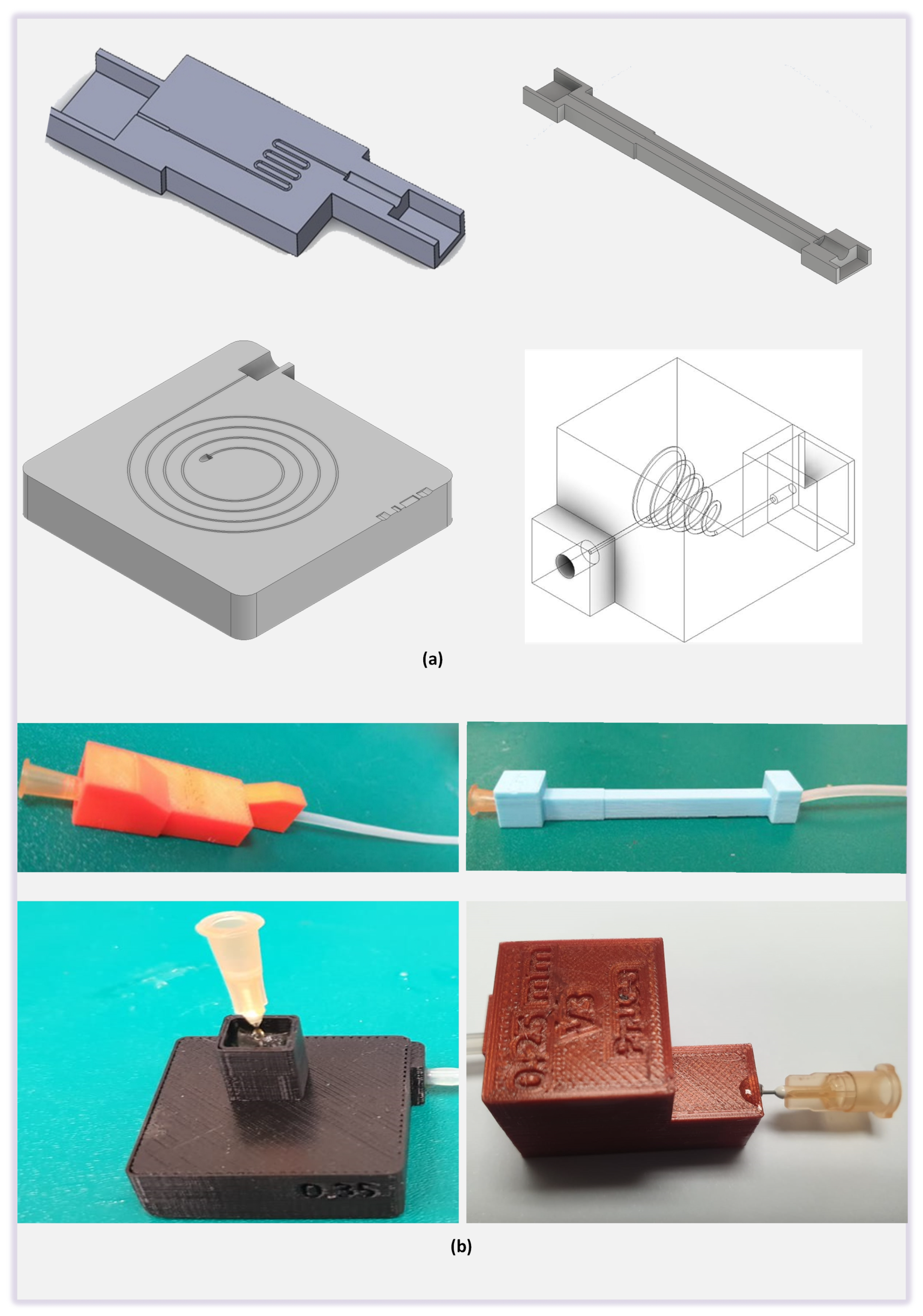

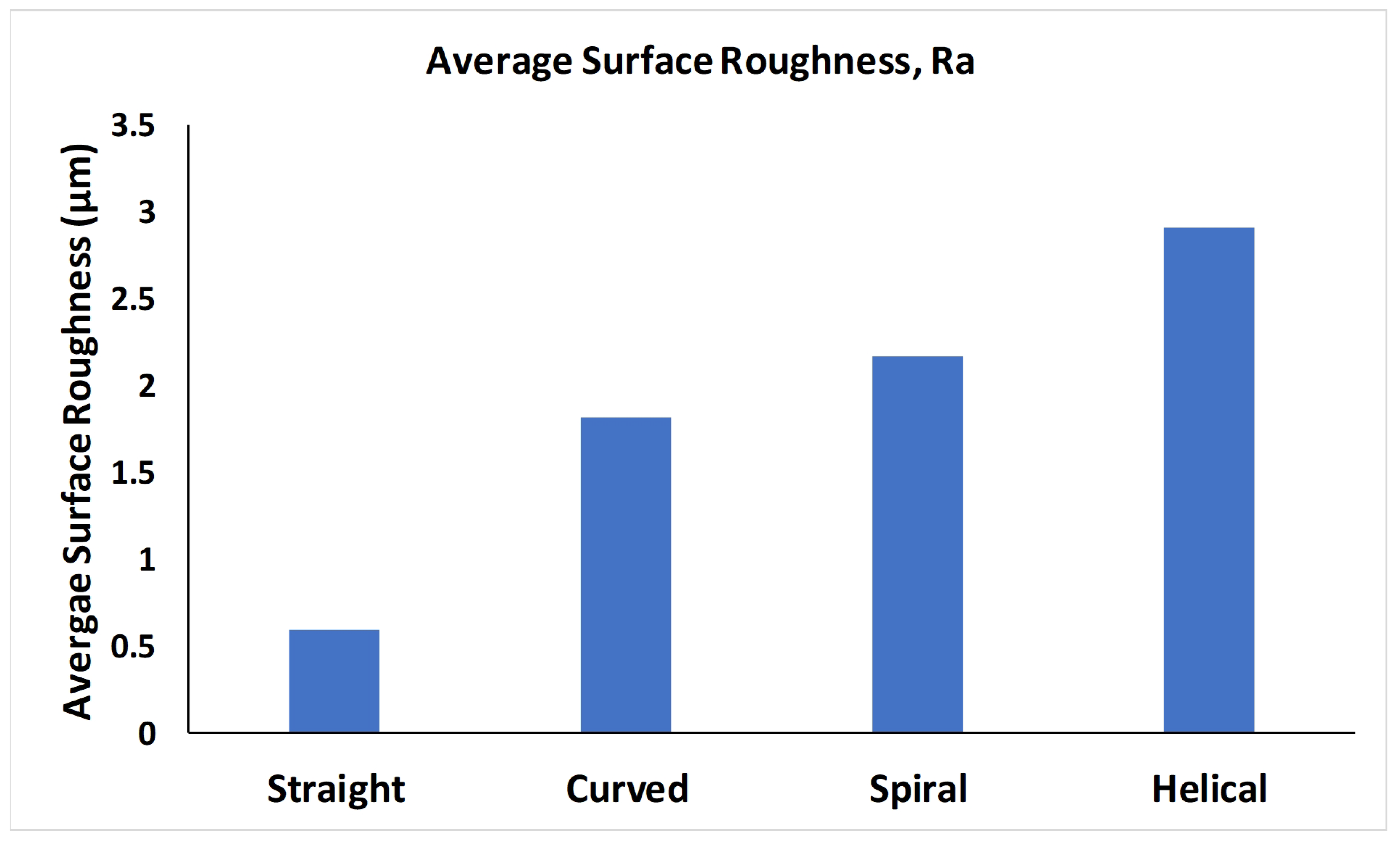
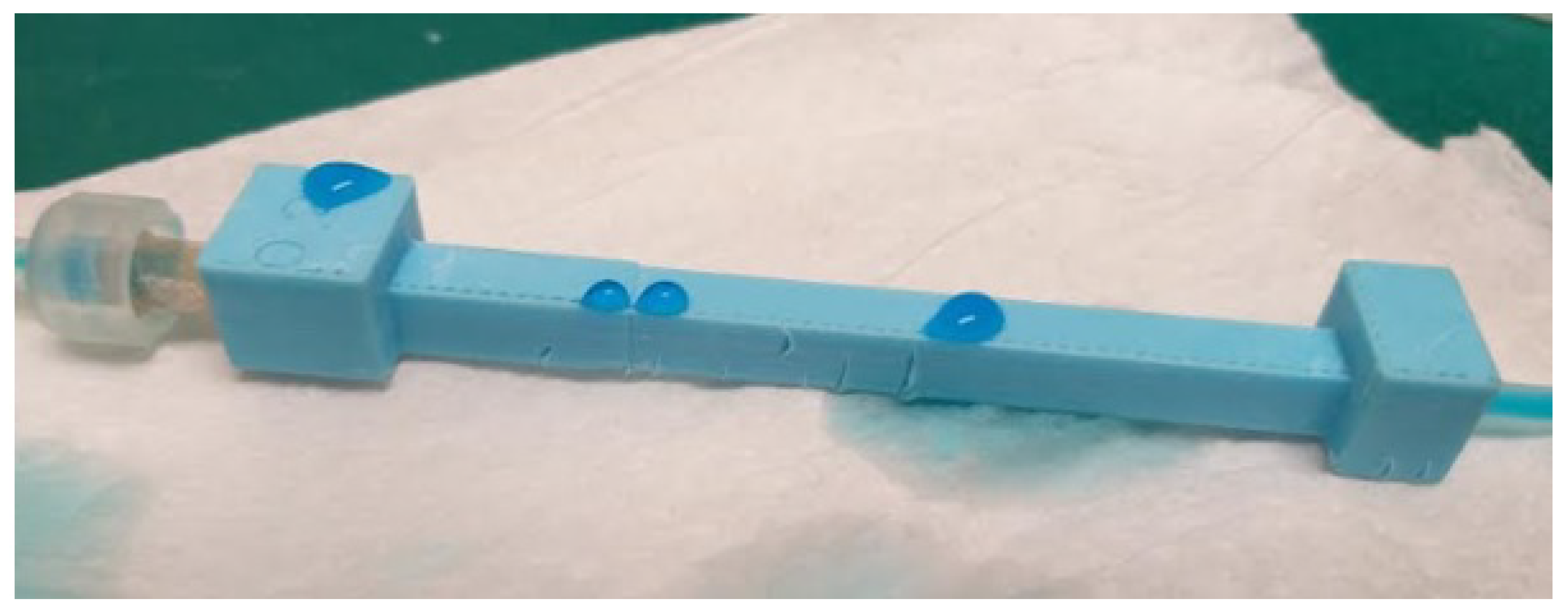
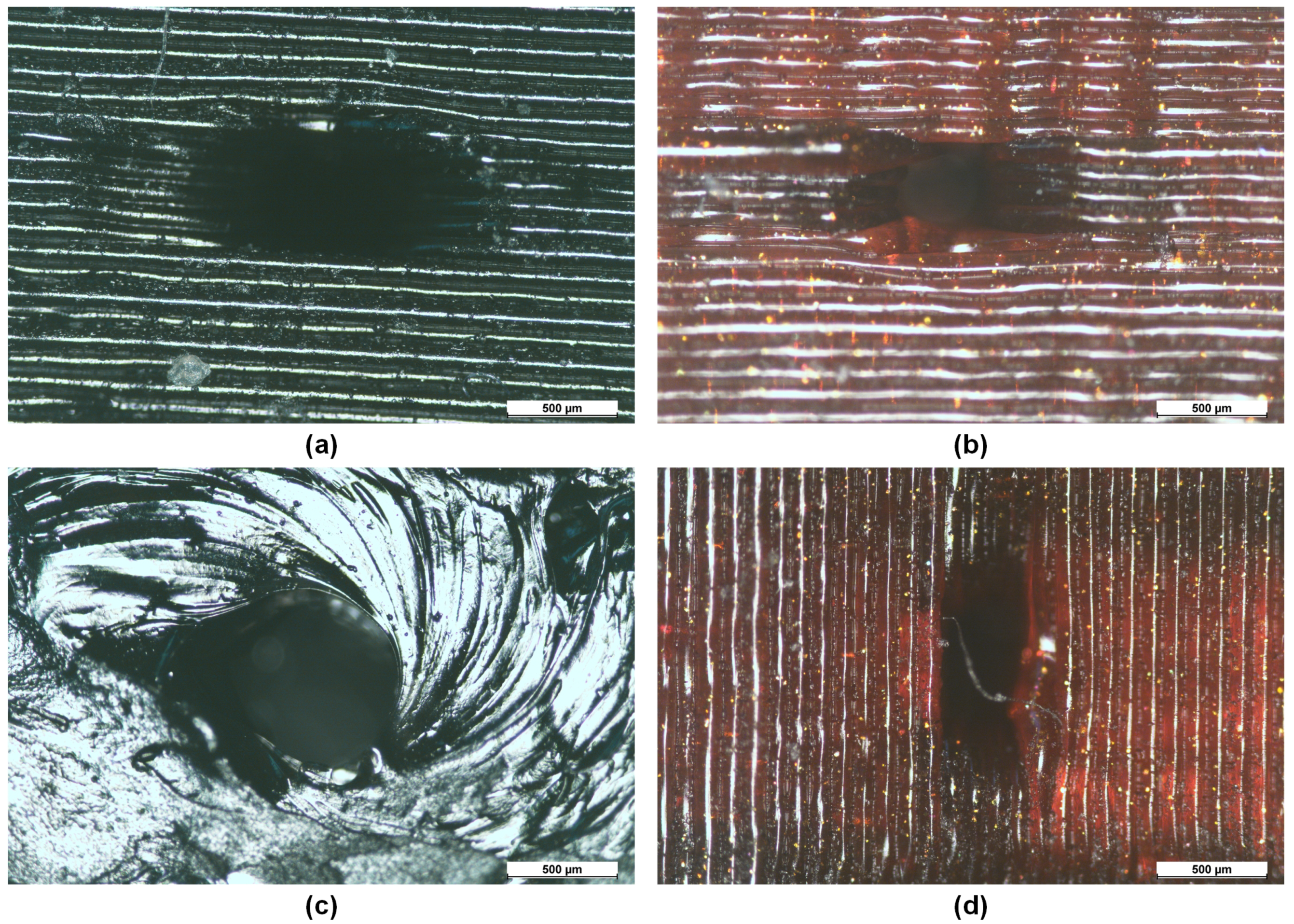
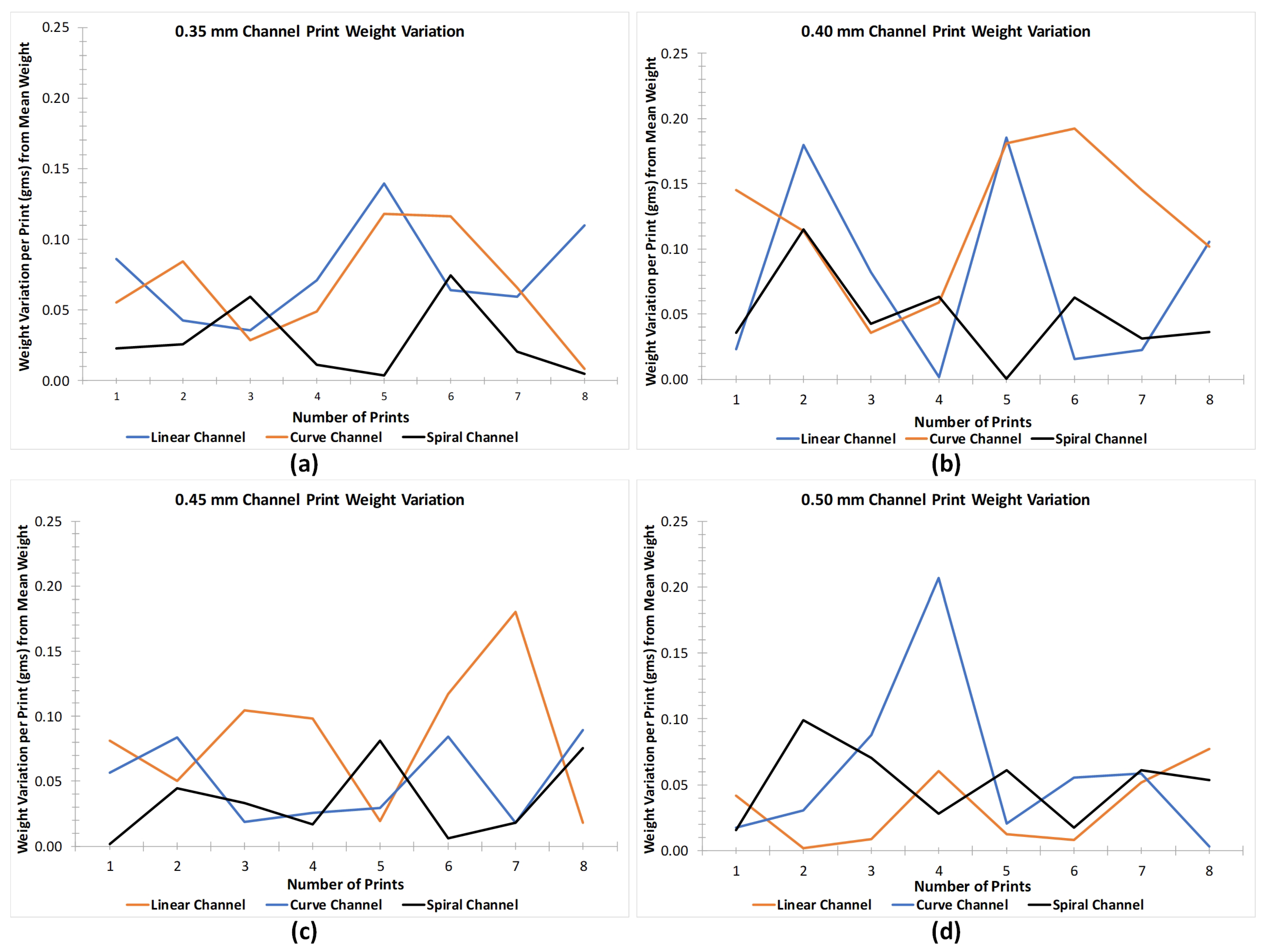
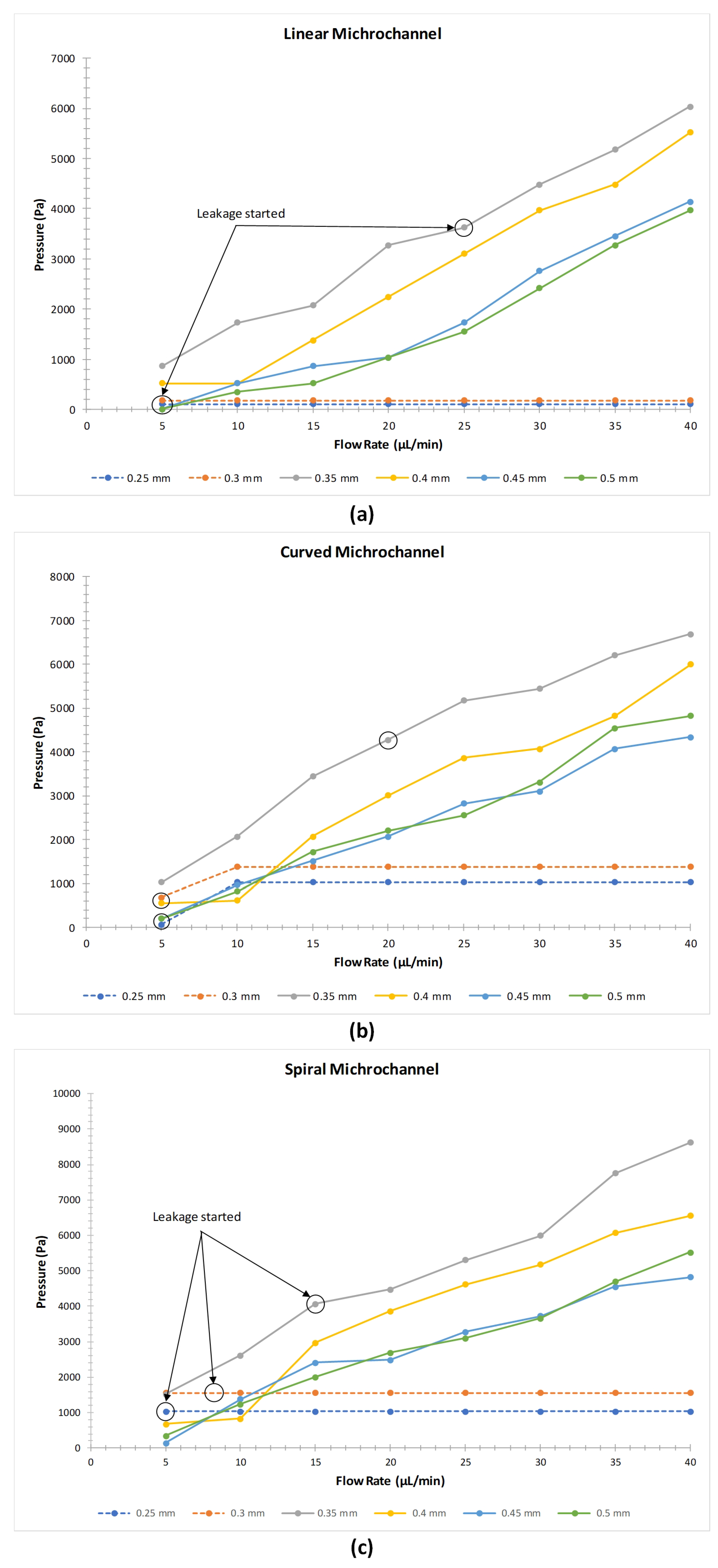
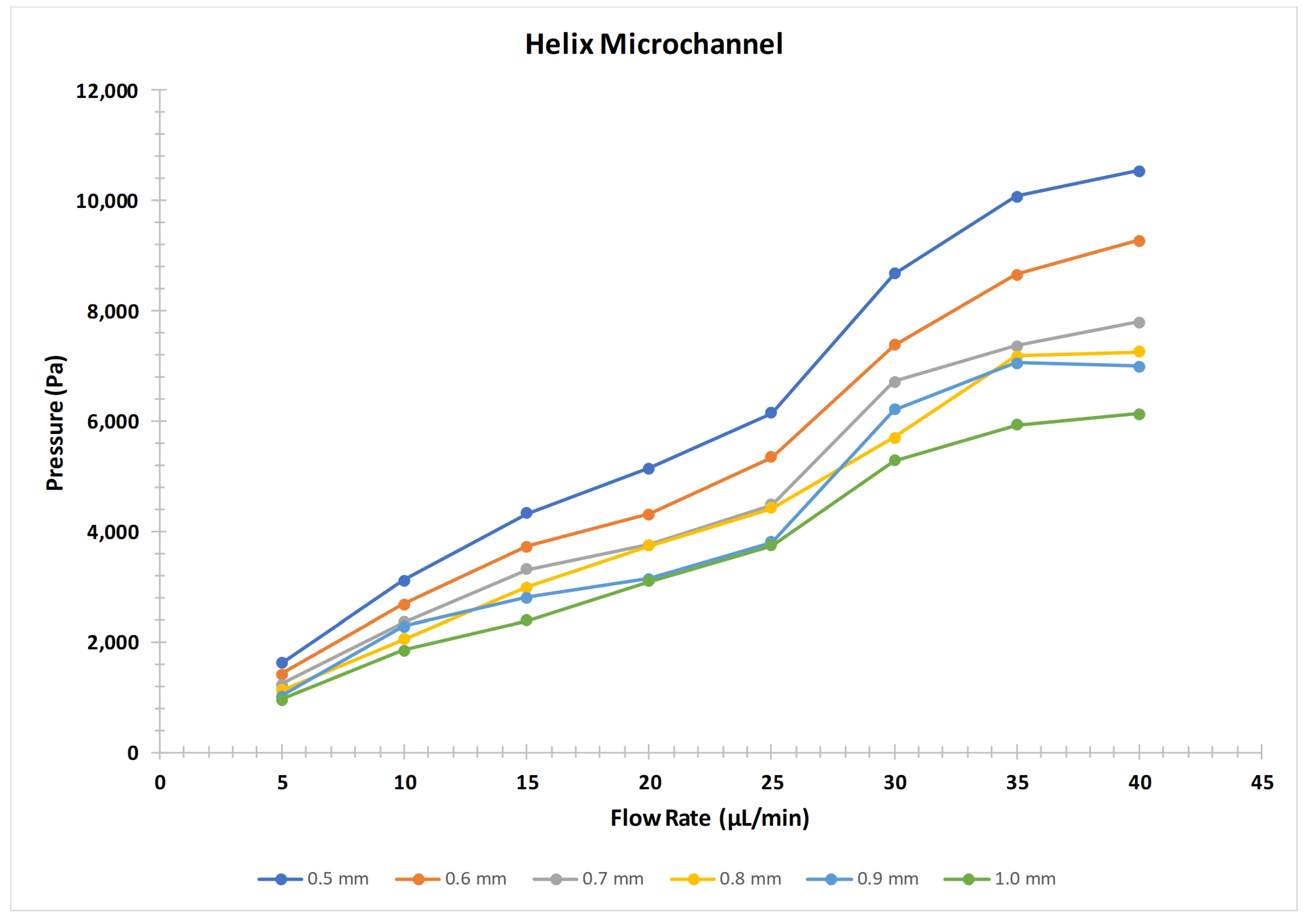
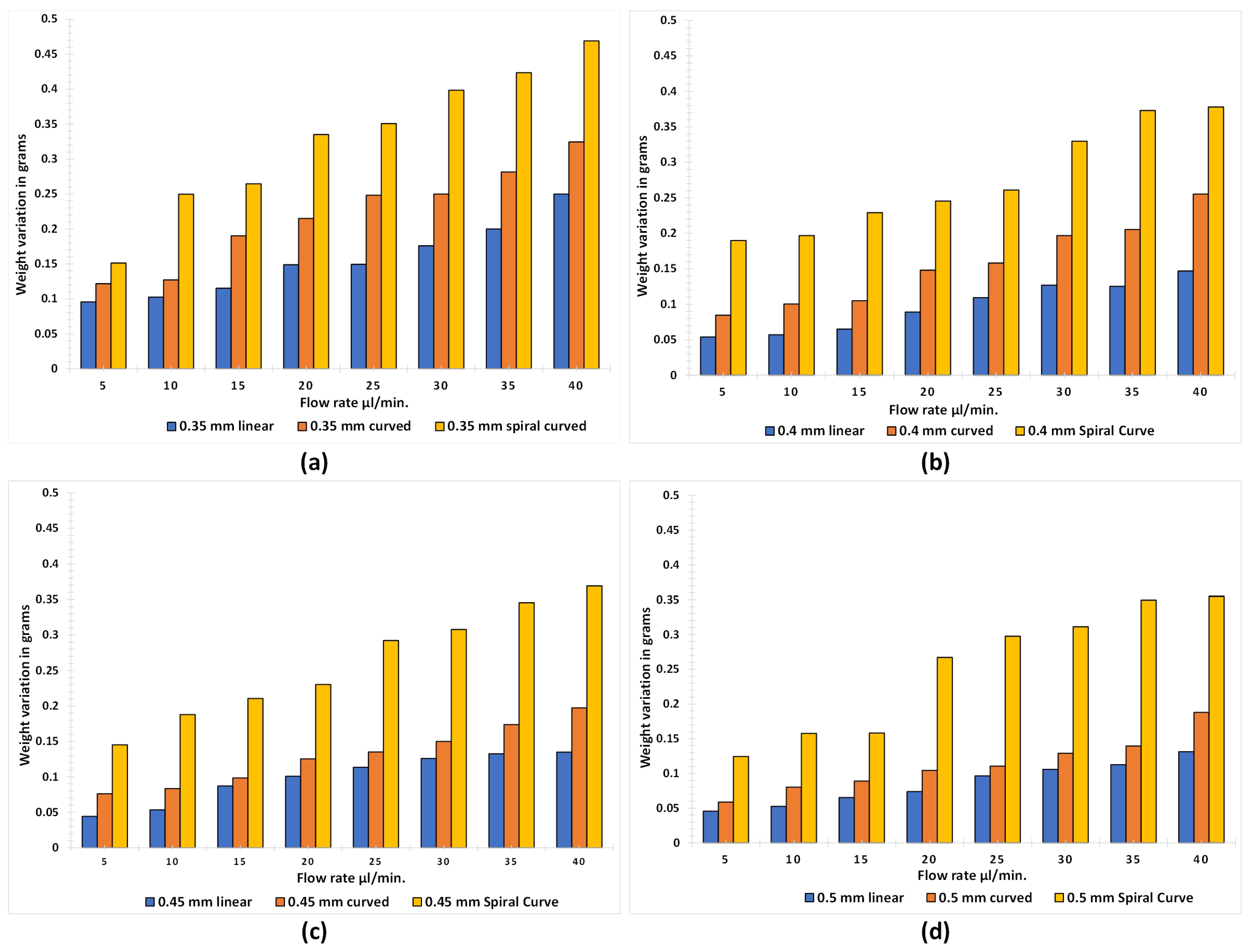
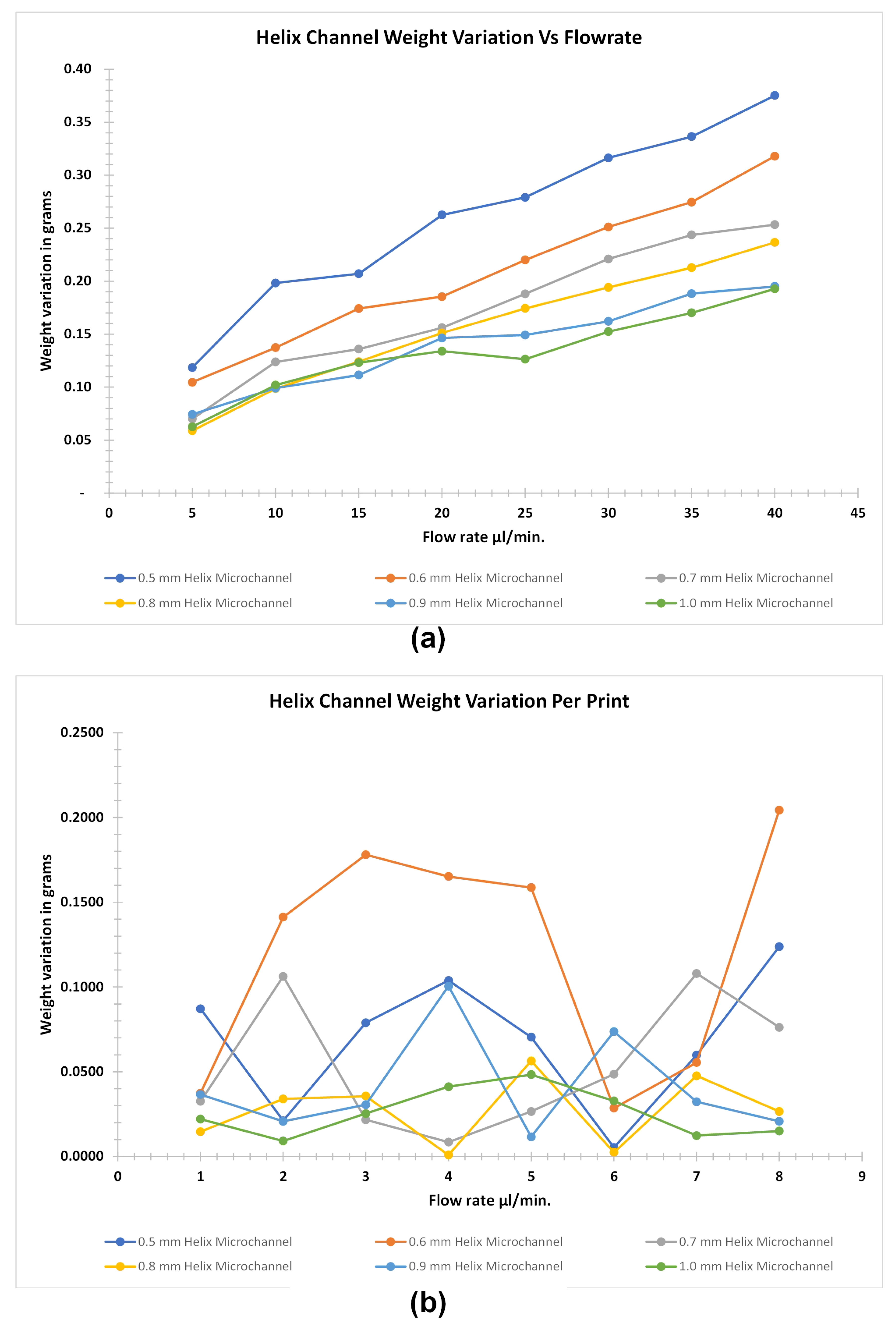
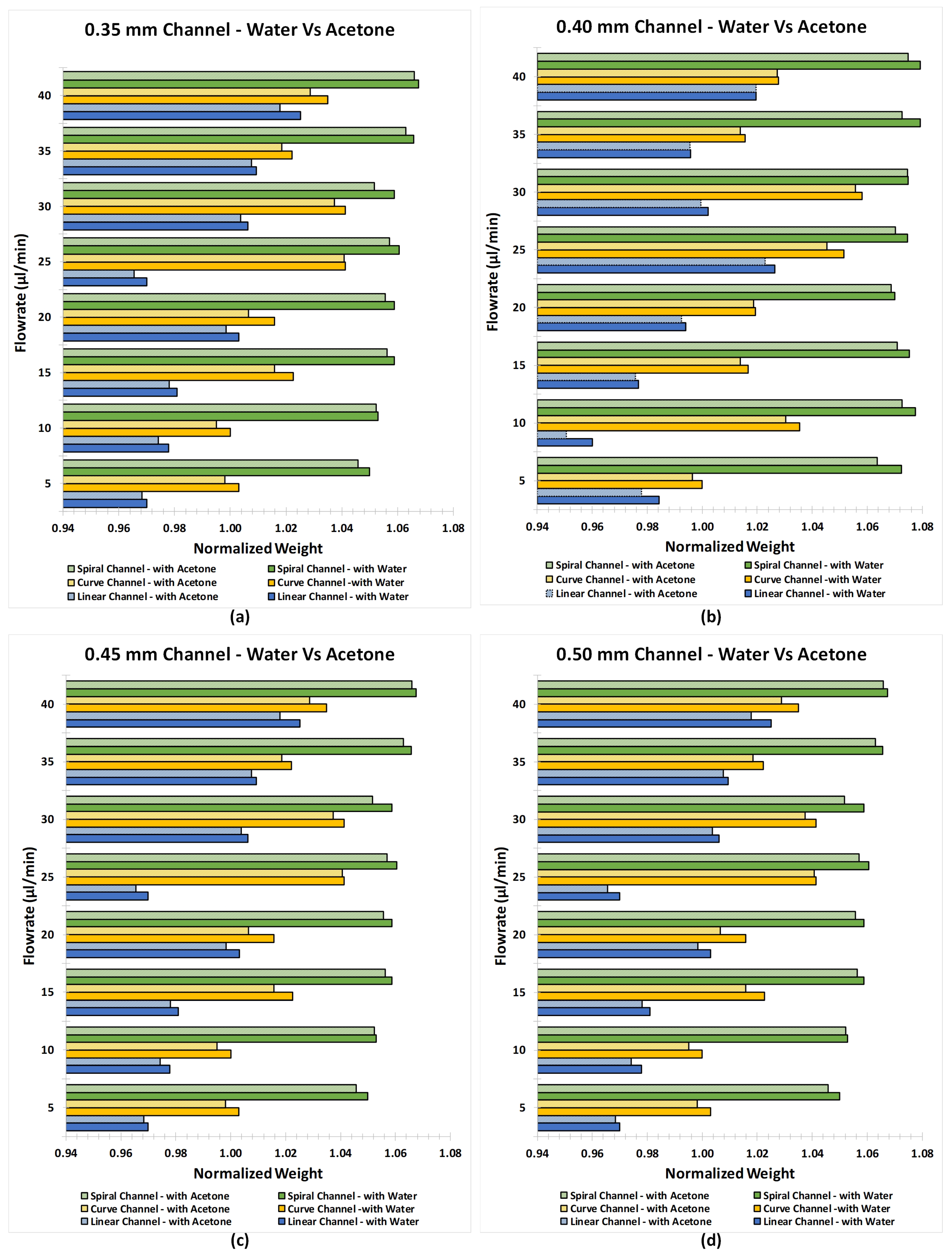
| Fabrication Technique for Microfluidics | Process | Typical Microfluidic Resolution (m) | Advantages | Disadvantages |
|---|---|---|---|---|
| Stereolithography | Point by Point laser scanning and curing of photocurable resin | 10–200 [38,39,40] | High resolution, can produce smoother and large parts with the capability of fabricating internal channels of microfluidics | High capital cost of equipment, photocurable raw material is often expensive and unsuitable for bio applications, printing parameters are intricate, and the equipment requires calibration for consistent print results |
| FDM | Layer-by-layer deposition of thermoplastic polymer extruded by applying heat and extrusion force to form 3D-printed features and microchannels | 400–1000 [41,42] | Low cost of equipment, printing material is biocompatible and low cost. Can produce highly complex internal microchannels with moderate sub millimetre resolution | Limited printing resolution and material often not suitable for high temperature applications |
| Selective Laser Sintering | Point by Point laser induced sintering of ceramic or metal particles to produce 3D parts | 100-600 [43] | Strength of parts is good, can produce parts with higher resolution and fabricated parts can be used in high temperature applications | High capital cost of equipment. Due to sintering the surface is rough, cleaning of internal microchannels is difficult |
| Soft Lithography | Stamping and moulding of elastomeric materials such as PDMS through contact printing, stamping or master mould imprinting [44]. | 0.05–0.5 [45] | Produces high resolution microchannels, fabricated devices are biocompatible [40] | Permeable for certain liquids and microchannels can swell due to reaction with certain chemicals. Multistep process, stripping of mould requires precision and expertise. Fabrication of complex 3D microchannel is difficult [46] |
| Inkjet Printing | Drop-on-demand (DoD) piezo-inkjet printing of ink which can be used to form open channel microfluidic, to form microfluidic path for positive or negative photoresist to use for etching or to form layer by layer adhesive structure for microfluidic applications | 42–300 [47] | Low cost, high speed, configurable and multimaterial parts can be manufactured [48]. | Strength of fabricated devices is low for enclosed channels and fabrication of internal microchannels requires further processing or processes |
| Xurography | Shearing of material through a sharp knife controlled through a computer-controlled software instructions [17]. | 15–250 [18,19] | Low cost of equipment, high speed and large area fabrication. | Complex 3D microchannel is extremely difficult to produce. |
| Specifications | Tiertime UP 02 | Prusa i3 MK3S |
|---|---|---|
| Make | Tiertime | Prusa Research |
| Software | UP Studio | Prusa Slicer and Pronterface |
| Machine Dimensions | 245 × 350 × 260 mm | 550 × 400 × 500 mm |
| Build Volume | 140 × 140 × 135 mm | 250 × 210 × 210 mm |
| Material Used | PLA (1.7 mm) | PLA (1.7 mm) |
| Nozzle diameter | 0.4 mm | 0.4 mm |
| Support Structure | No Support | No Support |
| Layer Thickness | 100 m | 100 m |
| In-Fill | 100% | 100% |
| Price | 799 USD [54] | 749 USD [55] |
| Parameter | Straight | Curved | Spiral | Helical |
|---|---|---|---|---|
| (All Values Are in m) | Channel | Channel | Channel | Channel |
| Roughness Average, | 0.598 | 1.817 | 2.170 | 2.907 |
| Average Maximum Height of the Profile, | 4.013 | 11.334 | 13.343 | 16.396 |
| Maximum Height of the Profile, | 4.888 | 13.146 | 16.740 | 21.784 |
| RMS Roughness, | 0.794 | 2.241 | 2.713 | 3.570 |
| Maximum Profile Peak Height, | 1.147 | 6.071 | 5.906 | 6.575 |
| Kurtosis, | 4.787 | 2.712 | 3.049 | 3.876 |
| Skewness, | 1.137 | 0.150 | 0.524 | 0.750 |
| Microchannel Design | Flow Rate (L/min) | Pressure (Pa) Microchannel Size (mm) | |||
|---|---|---|---|---|---|
| 0.35 | 0.4 | 0.45 | 0.5 | ||
| Linear | 5 | 862 | 517 | 0 | 0 |
| 10 | 1724 | 517 | 517 | 345 | |
| 15 | 2068 | 1379 | 862 | 517 | |
| 20 | 3275 | 2241 | 1034 | 1034 | |
| 25 | 3620 | 3103 | 1724 | 1551 | |
| 30 | 4482 | 3964 | 2758 | 2413 | |
| 35 | 5171 | 4482 | 3447 | 3275 | |
| 40 | 6033 | 5516 | 4137 | 3964 | |
| Curve | 5 | 1034 | 552 | 207 | 207 |
| 10 | 2068 | 621 | 965 | 827 | |
| 15 | 3447 | 2068 | 1517 | 1724 | |
| 20 | 4275 | 3006 | 2068 | 2206 | |
| 25 | 5171 | 3,861 | 2827 | 2551 | |
| 30 | 5447 | 4068 | 3103 | 3309 | |
| 35 | 6205 | 4826 | 4068 | 4551 | |
| 40 | 6688 | 5998 | 4344 | 4826 | |
| Spiral | 5 | 1517 | 676 | 138 | 345 |
| 10 | 2620 | 827 | 1379 | 1241 | |
| 15 | 4068 | 2965 | 2413 | 1999 | |
| 20 | 4482 | 3861 | 2482 | 2689 | |
| 25 | 5309 | 4619 | 3275 | 3103 | |
| 30 | 5998 | 5171 | 3723 | 3654 | |
| 35 | 7757 | 6067 | 4551 | 4688 | |
| 40 | 8618 | 6550 | 4826 | 5516 | |
Publisher’s Note: MDPI stays neutral with regard to jurisdictional claims in published maps and institutional affiliations. |
© 2020 by the authors. Licensee MDPI, Basel, Switzerland. This article is an open access article distributed under the terms and conditions of the Creative Commons Attribution (CC BY) license (http://creativecommons.org/licenses/by/4.0/).
Share and Cite
Rehmani, M.A.A.; Jaywant, S.A.; Arif, K.M. Study of Microchannels Fabricated Using Desktop Fused Deposition Modeling Systems. Micromachines 2021, 12, 14. https://doi.org/10.3390/mi12010014
Rehmani MAA, Jaywant SA, Arif KM. Study of Microchannels Fabricated Using Desktop Fused Deposition Modeling Systems. Micromachines. 2021; 12(1):14. https://doi.org/10.3390/mi12010014
Chicago/Turabian StyleRehmani, Muhammad Asif Ali, Swapna A. Jaywant, and Khalid Mahmood Arif. 2021. "Study of Microchannels Fabricated Using Desktop Fused Deposition Modeling Systems" Micromachines 12, no. 1: 14. https://doi.org/10.3390/mi12010014
APA StyleRehmani, M. A. A., Jaywant, S. A., & Arif, K. M. (2021). Study of Microchannels Fabricated Using Desktop Fused Deposition Modeling Systems. Micromachines, 12(1), 14. https://doi.org/10.3390/mi12010014







